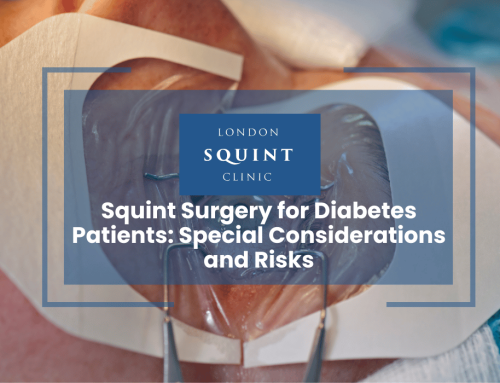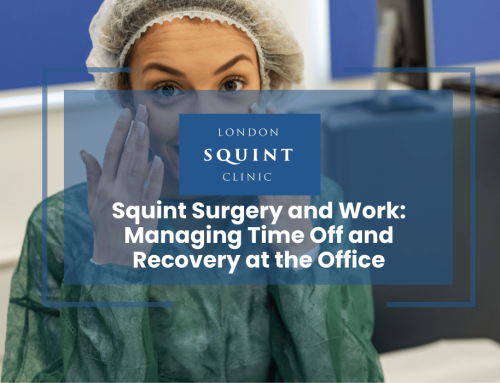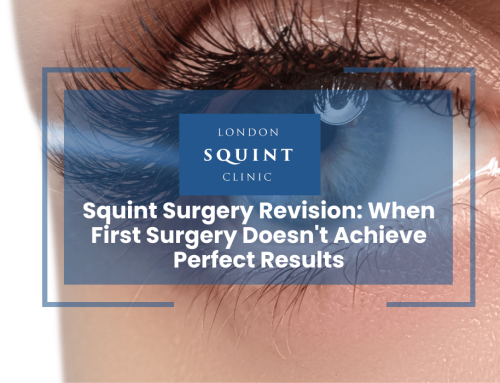Re-Do Squint Surgery: What to Expect After a Failed First Procedure
Re-Do Squint Surgery
- Revision squint surgery is common and viable, with 20-40% of patients potentially requiring a second procedure
- Success rates for adult revision procedures range from 60-80%, with most patients reporting satisfaction even with partial correction
- Wait at least 6-12 months between initial and revision surgeries to allow for complete healing and stabilization
- Recovery after revision surgery follows a similar timeline to initial procedures but may take longer due to previous scarring
- Proper post-operative care is crucial for optimal results, including medication adherence and avoiding activities that could disrupt healing
- Seek immediate medical attention for severe pain, sudden vision changes, or signs of infection after surgery
Table of Contents
- Understanding Failed Squint Surgery: Causes and Recognition
- Can Squint Surgery Be Done Twice? Exploring Second Procedures
- Preparing for Revision Strabismus Surgery: Essential Steps
- Recovery Timeline After Revision Squint Surgery
- Managing Expectations: Success Rates for Adult Re-Do Procedures
- Potential Side Effects and Complications of Revision Surgery
- Post-Surgery Care: Critical Precautions for Optimal Results
- When to Seek Medical Attention After Revision Strabismus Surgery
Understanding Failed Squint Surgery: Causes and Recognition
Squint surgery (strabismus surgery) is a common procedure to correct eye misalignment, but in some cases, the initial surgery may not achieve the desired results. Understanding what constitutes a “failed” procedure is crucial for patients considering revision surgery.
A squint surgery may be considered unsuccessful when the eyes remain misaligned after the recovery period, typically 6-8 weeks post-operation. This misalignment might be the same as before surgery, reduced but still noticeable, or in some cases, even worse than the pre-surgical condition. Additionally, some patients may experience initial improvement followed by gradual regression to the original squint.
Several factors can contribute to unsuccessful outcomes:
- Muscle scarring: Previous surgery can create scar tissue that affects muscle function
- Mechanical restrictions: Adhesions or fibrosis limiting eye movement
- Inaccurate measurements: Pre-surgical assessment may not have captured the full extent of the deviation
- Muscle slippage: Reattached muscles may slip from their new position during healing
- Underlying neurological factors: Some squints have neurological causes that surgery alone cannot fully address
- Age-related factors: While there is no strict squint surgery age limit, outcomes can vary with age
Recognition of a failed procedure typically occurs during follow-up appointments when your ophthalmologist evaluates eye alignment and vision. Patients may notice persistent double vision, continued cosmetic concerns, or failure to achieve binocular vision (the ability of both eyes to work together).
Can Squint Surgery Be Done Twice? Exploring Second Procedures
Yes, squint surgery can indeed be performed multiple times if necessary. Revision strabismus surgery (also called re-operation or re-do surgery) is a well-established practice in ophthalmology. Many patients wonder if after strabismus surgery is that your final eye position, and the answer is not always straightforward.
Second procedures are relatively common, with studies suggesting that approximately 20-40% of patients may require additional surgery to achieve optimal alignment. This is not necessarily a reflection of surgical failure but rather acknowledges the complex nature of eye muscle balance and the body’s healing response.
Revision surgery approaches include:
- Adjusting previously operated muscles: Fine-tuning the tension of muscles already addressed in the first surgery
- Operating on different muscles: Addressing additional eye muscles not included in the initial procedure
- Scar tissue management: Releasing adhesions that may have formed after the first surgery
- Adjustable suture techniques: Allowing for post-operative fine-tuning of muscle position
The timing between surgeries is crucial. Most ophthalmologists recommend waiting at least 6-12 months after the initial procedure before considering revision surgery. This allows for complete healing and stabilisation of the eye position, providing a clearer picture of the long-term outcome of the first surgery.
It’s worth noting that squint surgery outcomes tend to be more predictable in children than adults due to their greater neuroplasticity and adaptability. However, successful revisions are certainly possible at any age, though the approach may differ based on individual factors.
Preparing for Revision Strabismus Surgery: Essential Steps
Preparing for a second squint procedure requires thorough assessment and planning to address the specific issues that led to the suboptimal outcome of the first surgery. The preparation process is often more detailed than for the initial procedure.
Your ophthalmologist will conduct comprehensive evaluations including:
- Detailed measurements: Precise assessment of the angle of deviation in different gaze positions
- Forced duction testing: Evaluating if there are mechanical restrictions limiting eye movement
- Imaging studies: MRI or CT scans may be recommended to assess muscle position and identify scar tissue
- Review of previous surgical records: Understanding exactly what was done in the first procedure
- Assessment of vision: Comprehensive testing of visual acuity, depth perception, and binocular function
Pre-operative discussions will focus on realistic expectations. Your surgeon will explain that revision procedures can be more complex than initial surgeries due to altered anatomy and scar tissue. They will discuss the specific approach planned for your case, which may differ significantly from your first operation.
Practical preparation steps include:
- Discontinuing blood-thinning medications as advised (typically 1-2 weeks before surgery)
- Arranging for someone to accompany you home after the procedure
- Preparing your home environment for recovery (comfortable resting area, easy-to-reach necessities)
- Obtaining prescribed eye drops or medications in advance
- Following fasting instructions prior to surgery (usually no food or drink for 6-8 hours)
Many surgeons now use adjustable suture techniques for revision procedures, which may require the patient to be awake for final adjustments several hours after the main surgery. Your surgeon will explain if this approach is recommended for your specific case.
Recovery Timeline After Revision Squint Surgery
The squint surgery recovery time after a revision procedure often follows a similar pattern to the initial surgery, though some patients may experience slightly longer healing periods due to the presence of scar tissue and previous surgical changes. Understanding the typical timeline helps set realistic expectations.
First 24-48 Hours:
- Significant redness, swelling, and discomfort are common
- Vision may be blurry or doubled
- Light sensitivity is expected
- Prescribed pain medication and cold compresses can help manage discomfort
First Week:
- Redness and swelling begin to subside
- Eye discharge may be present but should diminish
- Vision starts to stabilise but may still fluctuate
- Most patients can return to light activities and desk work
2-3 Weeks After Strabismus Surgery:
- External healing is well underway
- Redness continues to fade but may still be noticeable
- Vision typically improves but may not yet be stable
- Many patients can resume normal activities with caution
- First follow-up assessment often occurs during this period
1-3 Months:
- External appearance returns to normal
- Eye alignment begins to stabilise
- Depth perception may improve if binocular vision develops
- Most physical restrictions are lifted
6-12 Months:
- Final eye position becomes apparent
- Internal healing is complete
- Long-term outcome can be assessed
It’s important to note that the timeline can vary significantly between individuals. Factors affecting recovery include age, extent of the revision surgery, presence of scar tissue, and individual healing capacity. Older patients may experience longer recovery periods than younger ones.
Managing Expectations: Success Rates for Adult Re-Do Procedures
Understanding how successful is strabismus surgery in adults, particularly for revision procedures, helps patients approach their treatment with realistic expectations. Success rates for revision squint surgery vary based on multiple factors, but research provides valuable insights.
For adult revision strabismus surgery, studies indicate success rates of approximately 60-80%, compared to 70-90% for primary procedures. This slight reduction reflects the increased complexity of operating on previously altered anatomy. However, these figures demonstrate that revision surgery remains a viable and often successful option for many patients.
Several factors influence the likelihood of success:
- Type and magnitude of squint: Smaller deviations typically have better outcomes
- Number of previous surgeries: Success rates tend to decrease with each additional procedure
- Time since original surgery: Long-standing misalignments may be more challenging to correct
- Presence of scarring: Extensive scarring can limit the mechanical effectiveness of surgery
- Underlying conditions: Thyroid eye disease, neurological issues, or trauma may affect outcomes
- Surgeon experience: Specialists with extensive revision surgery experience often achieve better results
It’s important to define what constitutes “success” in revision strabismus surgery. For some patients, the goal is perfect alignment, while for others, it may be reduction of double vision or improved cosmetic appearance. Your surgeon will discuss your specific goals and the likelihood of achieving them.
Many patients experience significant improvement even if perfect alignment isn’t achieved. Studies show that approximately 85% of adult patients report satisfaction with their revision surgery results, even when measurements indicate less than perfect alignment. This reflects the meaningful improvement in quality of life that can occur even with partial correction.
Potential Side Effects and Complications of Revision Surgery
Revision strabismus surgery carries similar risks to initial procedures, but some squint surgery side effects and complications may occur with higher frequency or severity due to the altered anatomy and presence of scar tissue. Being aware of these potential issues helps patients make informed decisions and recognise when to seek medical attention.
Common Side Effects (Expected and Usually Temporary):
- Redness and swelling: Often more pronounced than after initial surgery
- Discomfort or pain: Usually manageable with prescribed medication
- Double vision: Common in the early recovery period as the brain adjusts
- Light sensitivity: May persist for several weeks
- Foreign body sensation: Feeling of grittiness or something in the eye
- Temporary change in eyelid position: Usually resolves within weeks
Less Common Complications:
- Persistent double vision: May occur in positions of gaze where it wasn’t present before
- Under or overcorrection: The eyes may still be misaligned, possibly requiring further surgery
- Restricted eye movement: Due to muscle scarring or altered function
- Eyelid malposition: Drooping or retraction that persists beyond the recovery period
- Infection: Rare but requires prompt treatment
- Anterior segment ischemia: Reduced blood flow to the front portion of the eye
- Lost or slipped muscle: More common in revision surgery due to scarring
Rare but Serious Complications:
- Perforation of the globe: Accidental puncture of the eyeball
- Retinal detachment: Separation of the light-sensitive tissue at the back of the eye
- Vision loss: Extremely rare but possible
- Allergic reaction: To medications or materials used during surgery
The risk of complications increases with the number of previous surgeries and the extent of existing scar tissue. Your surgeon will discuss your specific risk profile based on your medical history and the planned surgical approach.
Post-Surgery Care: Critical Precautions for Optimal Results
Understanding what not to do after strabismus surgery is crucial for optimising your recovery and final outcome. Proper post-operative care is particularly important for revision procedures, as the healing process may be more complex than after initial surgery. Following these precautions after squint surgery can significantly impact your results.
Essential Post-Operative Care:
- Medication adherence: Use prescribed antibiotic and anti-inflammatory eye drops exactly as directed
- Eye protection: Wear protective shields while sleeping for the duration recommended by your surgeon (typically 1-2 weeks)
- Gentle cleaning: Keep the eye area clean using only the recommended method (usually sterile saline wipes)
- Rest: Allow adequate time for recovery, especially in the first week
- Follow-up appointments: Attend all scheduled check-ups to monitor healing and alignment
Key Restrictions – What to Avoid:
- Rubbing or touching the eyes: This can disrupt sutures and introduce infection
- Swimming or hot tubs: Avoid for at least 2-3 weeks to prevent infection
- Heavy lifting: Avoid lifting more than 5kg for at least 2 weeks
- Strenuous exercise: Postpone vigorous activities for 3-4 weeks
- Eye makeup: Avoid for at least 2 weeks post-surgery
- Contact lenses: Do not use until approved by your surgeon (typically 3-4 weeks)
- Dusty or smoky environments: These can irritate the healing eye
Lifestyle Adaptations
Frequently Asked Questions
How long after failed squint surgery can revision be performed?
Most ophthalmologists recommend waiting 6-12 months after the initial squint surgery before performing a revision procedure. This waiting period allows for complete healing and stabilization of the eye position, providing a clearer picture of the long-term outcome of the first surgery. The exact timing may vary based on individual factors such as the extent of scarring, the type of misalignment, and your overall health condition.
What is the success rate for revision strabismus surgery in adults?
Revision strabismus surgery in adults has a success rate of approximately 60-80%, compared to 70-90% for primary procedures. This slight reduction reflects the increased complexity of operating on previously altered anatomy. However, about 85% of adult patients report satisfaction with their revision surgery results, even when measurements indicate less than perfect alignment, as they experience meaningful improvement in quality of life.
Can squint surgery be done a third time if the second procedure fails?
Yes, squint surgery can be performed multiple times if necessary, including a third procedure. However, each additional surgery typically has a lower success rate due to increased scarring and altered anatomy. The decision for a third surgery should be made after careful consideration of the potential benefits versus risks, and is best discussed with a specialist experienced in complex strabismus cases.
What causes squint surgery to fail?
Squint surgery may fail due to several factors including muscle scarring, mechanical restrictions from adhesions or fibrosis, inaccurate pre-surgical measurements, muscle slippage during healing, underlying neurological factors that surgery alone cannot address, and age-related factors affecting tissue elasticity and healing. The complexity of eye muscle balance and the body’s individual healing response also play significant roles in surgical outcomes.
How long is the recovery period after revision squint surgery?
Recovery after revision squint surgery typically follows this timeline: significant redness and swelling for the first 48 hours; gradual improvement during the first week; external healing well underway by 2-3 weeks; return to normal appearance by 1-3 months; and final eye position becoming apparent by 6-12 months. Recovery may be slightly longer than initial surgery due to scar tissue and previous surgical changes, and can vary based on age, extent of surgery, and individual healing capacity.
What restrictions should I follow after revision strabismus surgery?
After revision strabismus surgery, avoid rubbing or touching your eyes, swimming or using hot tubs for 2-3 weeks, heavy lifting (over 5kg) for at least 2 weeks, strenuous exercise for 3-4 weeks, eye makeup for 2 weeks, and contact lenses until approved by your surgeon (typically 3-4 weeks). Additionally, avoid dusty or smoky environments, and follow your surgeon’s specific instructions regarding medication, eye protection, and follow-up appointments.
When should I seek immediate medical attention after revision squint surgery?
Seek immediate medical attention after revision squint surgery if you experience severe or worsening pain not relieved by prescribed medication, sudden decrease in vision, significant swelling or discharge, unusual redness that worsens after the first few days, severe headache or nausea, or signs of infection such as fever or increasing eye redness with yellow/green discharge. These symptoms could indicate serious complications requiring prompt treatment.
Find out if you are suitable for Double Vision Treatment
Not everyone is eligible for double vision surgery.
Find out if you could benefit from this life-changing surgery by taking the quick self-suitability quiz below:
Our most popular procedures

Hello, I’m Nadeem Ali
I’m one of the few eye surgeons in the world with 100% focus on Squint and Double Vision Surgery.
I have 24 years of eye surgery experience, and worked for 13 years as a Consultant at London’s renowned Moorfields Eye Hospital.
In 2023, I left the NHS to focus fully on treating patients from across the world at the London Squint Clinic. You can read more about me here.
There’s lots of information on the website about: squint surgery, double vision surgery and our pricing.
The most rewarding part of my job is hearing patients tell me how squint or double vision surgery has changed their lives. You can hear these stories here.
Mr Nadeem Ali
MA MB BChir MRCOphth FRCSEd(Ophth)





